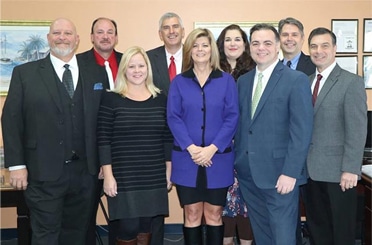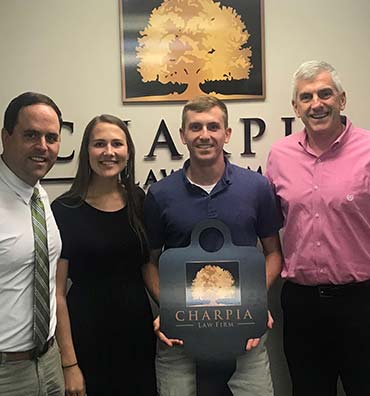Classic Home Mortgage Providing Trustworthy Mortgage Guidance for Over 30 Years
Buying a home is one of the most significant investments that you will ever make. Like most good things, finding the perfect home comes with a lot of work. From your initial search online to your home tour and finally closing, there are many difficult decisions to make along the way. The bottom line is that the entire home buying process can be very stressful, especially when it comes to finding the right mortgage broker and loan for your new home. Since market conditions and mortgage programs change frequently, you have a lot riding on your broker's ability to provide quick and accurate financial advice. Whether you're a first-time homebuyer or own several residential properties, you need a mortgage broker in Satellite Beach, FL, who can educate you on mortgage rates and provide trustworthy guidance to help you make an informed decision.
My name is Dan Crance - Satellite Beach's most trusted mortgage loan officer with more than 30 years in the mortgage industry. I bring unparalleled insight and decades of experience into your home loan process. If you're looking for a new home loan, are interested in refinancing your current mortgage, or need information regarding FHA, VA, or other types of loans, Dan Crance is Your Mortgage Man.
Unlike some mortgage loan officers in Satellite Beach, my primary goal is to help you make the right mortgage choice for you and your family. Mortgage lenders have a horrible reputation for turning over clients quickly to expedite cash flow and make the most money possible. While some mortgage brokers come off as pushy and impatient, I encourage my clients to take as much time as they need to ask questions and review their mortgage agreements. I'm here to help answer those questions and provide you with easy-to-understand advice so that you can rest easy knowing you made the right choice. I could say that I strive to provide service that exceeds your expectations, but I'd rather show you. In the end, I want you to leave feeling confident in the loan you've selected, as well as in your choice of broker.
Service Areas



Why Choose Dan Crance As Your Mortgage Lender in Satellite Beach, FL?
Clients choose my mortgage company because I truly care about helping them navigate the often-confusing landscape of the mortgage process. I am fiercely dedicated to my clients and make every effort to provide them with trustworthy advice and an open line of communication.
In my business, I work for two different customers. On one hand, I have the buyer: the person entrusting me with the responsibility of guiding them through one of the most important decisions ever. Serving homebuyers is not a task that I take lightly. I work with them daily to help them through the process and provide timely updates and news on their mortgage status. On the other hand, I have the realtor: the person who works with my client to find their dream home. Since their commission is in my hands, working with realtors is also a very important task. I update these agents on the status of their customers weekly. Only when I take care of both parties can I say my job as a mortgage loan officer is complete.
As a mortgage broker with more than 30 years of experience, I pledge to give you the highest level of customer service while providing you with the most competitive loan products available. That way, you can buy the home of your dreams without second-guessing your decision.

Home Financing in Satellite Beach, FL
At Classic Home Mortgage, our team works diligently to close on time without stress or hassle. Whether you're a seasoned homeowner or are buying your new home in Satellite Beach, we understand how much stress is involved. Our goal is to help take that stress off of your plate by walking you through every step of the home loan process. Because every one of our clients is different, we examine each loan with fresh eyes and a personalized approach, to find you the options and programs you need.
With over 30 years as a mortgage professional in Satellite Beach, Dan Crance will help you choose the home loan, interest rate, term options, and payment plans that fit your unique situation.

When you work with Classic Home Mortgage, you can always count on our team to:
- Put your needs first.
- Work efficiently and quickly. Many of our home loans close in 30 days or less.
- Offer you a variety of home loans to choose from, and help you make an informed decision.
- Provide you with competitive rates that make sense for your budget and lifestyle.
While no two loan terms are the same, a few of the most common loan types include:
30-Year Loan - This loan is often considered the most secure option to choose. With a 30-year loan, you can lock in a low payment amount and rest easy knowing your rate won't change.
FHA Loan - If you're not able to make a large down payment, an FHA loan could be the right choice for you. With an FHA loan, many of our clients have successfully purchased a home with less than 4% down.
VA Loan - This loan is reserved for military veterans and active-duty men and women. Those who qualify may be able to purchase a home with no down payment and no Private Mortgage Insurance (PMI).
Choosing a home loan is an important step in the home buying process. At Classic Home Mortgage, we are here to make choosing a loan as easy as possible, so you can focus on the joys of being a homeowner. Contact our team of experts today and ask how you can get pre-qualified for your home loan in Satellite Beach, FL.
Refinancing in
Satellite Beach, FL
Because home mortgage rates in the U.S. have been so low over the last year, many current homeowners are opting to refinance their home loans. Simply put, refinancing is replacing your existing mortgage with a different mortgage under new terms. Homeowners who refinance their homes enjoy lower interest rates, lower monthly payments, and even turn their home's equity into cash. If you're interested in refinancing your home, it all begins with a call to your mortgage broker in Satellite Beach, FL - Dan Crance.
Here are just a few reasons why more homeowners in the U.S. are taking advantage of lower rates and refinancing their homes:


Shorter Term Loan
Refinancing from a 30-year to a 15-year mortgage might seem counterproductive on the surface because your monthly payment usually goes up. However, interest rates on 15-year mortgages are lower. And when you shave off years of your previous mortgage, you will pay less interest over time. These savings can be very beneficial if you are not taking the mortgage interest deduction on your tax returns.

Do Away with FHA
FHA loans are notorious for paying premiums for the life of the loan. Mortgage insurance premiums for FHA loans can cost borrowers as much as $1,050 a year for every $100k borrowed. The only way to get rid of mortgage insurance premiums is to refinance to a new loan that the Federal Housing Authority does not back.

Switch to Fixed Rate or Adjustable-Rate Home Loan
Sometimes, borrowers with adjustable-rate mortgages refinance so they can switch to a fixed rate, which lets them lock in an interest rate. Doing so is beneficial for some homeowners who like to know exactly how much their monthly payment is each month. Conversely, some homeowners with fixed rates prefer to refinance to an adjustable-rate mortgage. Homeowners often go this route if they plan on selling in a few years and don't mind risking a higher rate if their plans fall through.

Common Questions About Home Loans
Finding the right loan can be a difficult proposition, even if you have been through the process before. This is especially true since mortgage rates and market conditions change frequently. If you're like most of my clients, you probably have questions about interest rates, refinancing options, and a litany of other topics. To help alleviate some of your stress, here are just a few common questions with answers so that you can better educate yourself as we work our way to securing your loan.


Trust Dan Crance
Your Mortgage Lender in Satellite Beach, FL
Whether you're selling, buying, refinancing, or building the home of your dreams, you have a lot riding on your home loan specialist. When you need a mortgage broker who works tirelessly for you, answers your questions, provides guidance, and does so with a genuine smile, Dan Crance is your mortgage man. Contact Dan today at 843-478-5612 to get pre-approved and discover why Satellite Beach loves Classic Home Mortgage.
After hours by appointment only. CONTACT DANLatest News in Satellite Beach, FL
BREVARD HISTORY: Satellite Beach is a Relatively New Town by Florida Standards, Incorporated in 1957
Forida-Backroads-Travel.comhttps://spacecoastdaily.com/2023/10/brevard-history-satellite-beach-is-a-relatively-new-town-by-florida-standards-incorporated-in-1957/
ABOVE VIDEO: PART 1 – The City of Satellite Beach was incorporated in 1957 and is relatively new by Florida Standards. (City of Satellite Beach video)ABOVE VIDEO: PART 2 – The City of Satellite Beach was incorporated in 1957 and is relatively new by Florida Standards. (City ...
ABOVE VIDEO: PART 1 – The City of Satellite Beach was incorporated in 1957 and is relatively new by Florida Standards. (City of Satellite Beach video)
ABOVE VIDEO: PART 2 – The City of Satellite Beach was incorporated in 1957 and is relatively new by Florida Standards. (City of Satellite Beach video)
ABOVE VIDEO: Part 3 – The City of Satellite Beach was incorporated in 1957 and is relatively new by Florida Standards. (City of Satellite Beach video)
ABOVE VIDEO: PART 4 – The City of Satellite Beach was incorporated in 1957 and is relatively new by Florida Standards. (City of Satellite Beach video)
It was incorporated in 1957 and is on the barrier island south of Patrick Air Force Base and north of another relatively new town, Indian Harbour Beach. It has a population of about 10,000 and is bordered by the Atlantic Ocean to the east and the Banana River on the west.
Brevard County had a severe housing shortage in the 1950s and 1960s due to the rapid build-up of employment at Cape Canaveral and later Kennedy Space Center in support of the Mercury, Gemini and Apollo program designed to put a man on the moon by the end of the 1960s.
Satellite Beach became one of the residential communities built to handle this extreme demand and was founded by Percy L. Hedgecock. He and his brother-in-law, Jimmy Caudle and cousin Dumont Smith, were originally from North Carolina and came down to develop real estate in the area.
Related Story:BREVARD HISTORY: ‘Indialantic-by-the-Sea’ Started In 1915 By Ernest Kouwen-Hoven
They built many of the original houses in the community and Hedgecock was the mayor of the new town from 1957 to 1973.
Most of the buildings in this little city were built after its founding in 1957, but one old building of interest is Holy Apostles Episcopal Church, located at 505 Grant Avenue.
This church was originally built in Fort Pierce, Florida in 1902 and was barged up the Indian River Lagoon some 60 miles from its original location and placed in Satellite Beach in 1959.
So even though the town was only two years old at the time, it had a historic church that is an excellent example of Carpenter Gothic architecture. It was also the first church in Satellite Beach.
One of the things that makes Florida a fun place to live is that there are many places that didn’t even exist just a few years ago. It’s easy to learn their history and even be a part of it.
And it makes you appreciate Old Florida and the back roads even more.
– Florida-Backroads-Travel.com
CLICK HERE FOR BREVARD COUNTY NEWS
$80 a boot: Satellite Beach parking enforcement frustrating visitors
Esther Bowerhttps://www.fox35orlando.com/news/80-a-boot-satellite-beach-parking-enforcement-frustrating-visitors
Imagine going to the beach and fishing for a few hours only to come back and find a car boot on your tire – preventing you from leaving.It happened to Johnny Durante, whose vehicle was booted on Wednesday."I've been booted for no reason. I'm out there fishing – I come back, and I'm booted," he said."Yesterday there were two booted (vehicles) when I pulled in, and then just this morning, 15 minutes ago, there was another van that was booted," said Jim Katanski, who frequents Satellite Beach...
Imagine going to the beach and fishing for a few hours only to come back and find a car boot on your tire – preventing you from leaving.
It happened to Johnny Durante, whose vehicle was booted on Wednesday.
"I've been booted for no reason. I'm out there fishing – I come back, and I'm booted," he said.
"Yesterday there were two booted (vehicles) when I pulled in, and then just this morning, 15 minutes ago, there was another van that was booted," said Jim Katanski, who frequents Satellite Beach often.
Satellite Beach, a coastal city in Brevard County, Florida, stopped allowing people to park at the beach for free. The change went into effect months ago. However, issuing tickets and warnings wasn't enough, so enforcement increased.
It's $2.50 an hour to parking at Satellite Beach. Those who do not pay or whose parking time expired, may be hit with a boot – and it's $80 to have it removed. Some residents believe the city has taken enforcement too far.
"Ticketing is not generally that effective, and we are just trying to get compliance," said City Manager Courtney Barker.
The city is using a private parking enforcement company to monitor beach parking lots and chose the boots to make sure they get paid if people don’t pay the hourly and daily rates.
Besides the unexpected fee, it's also causing people frustration about how to get the boot off – and whom to call.
"I don’t feel good, Durant said. "They’re stealing."
Others worry the new enforcement tool will push visitors away from the Space Coast.
"College campuses were really strict about booting, so I definitely don’t want to go through that again," said Harrison Hillenmeyer, who’s from Cocoa Beach and visited Satellite for the first time since moving.
"This is not the way to encourage people to come to your city," said Brevard County resident, Sandra Sullivan.
The city said booting vehicles is not going away, but residents can apply for a free yearly parking pass.
Satellite Beach Parking Program Offering Free Hightower, Pelican Beach Pass for Brevard County Residents
Space Coast Dailyhttps://spacecoastdaily.com/2023/10/satellite-beach-parking-program-offering-free-hightower-pelican-beach-pass-for-brevard-county-residents/
BREVARD COUNTY • SATELLITE BEACH, FLORIDA – Residents who have secured a parking permit through the City of Satellite Beach’s new Beach Parking Fee Program are encouraged to verify the license plate number in the system before visiting the beach.The Beach Parking Program went into effect on September 15, with hourly, daily, and annual parking rates. Annual Parking Permits are available online and require a minimum of 72 hours to be processed.The program uses license plates, not...
BREVARD COUNTY • SATELLITE BEACH, FLORIDA – Residents who have secured a parking permit through the City of Satellite Beach’s new Beach Parking Fee Program are encouraged to verify the license plate number in the system before visiting the beach.
The Beach Parking Program went into effect on September 15, with hourly, daily, and annual parking rates. Annual Parking Permits are available online and require a minimum of 72 hours to be processed.
The program uses license plates, not stickers, to track passes. Residents who have applied for a parking permit are encouraged to double-check their license plate information in the system before visiting the beach.
Both Hightower Beach Park and Pelican Beach Park are former county-owned properties, which were deeded to the City of Satellite Beach in 2013.
Parking at these locations will remain free for all Brevard County residents with proper passes, which can be obtained at the City of Satellite Beach parking website. Passes will be required for other Satellite Beach beachside parking areas.
Satellite Beach has implemented these daily parking rates:
? Brevard County residents are eligible to obtain a free annual pass that will allow parking at Hightower Beach East Parking Lot and Pelican Beach Park without being required to pay the daily parking rates.
? For anyone residing outside of Satellite Beach city limits, the annual pass rate is $75 for access to ALL of the beach parking areas within the City of Satellite Beach, or $2.50 per hour with a maximum of $10 per day. A mobile phone convenience fee of $0.35 will be added to each mobile phone payment.
? Brevard County residents wishing to visit any other beachside park within Satellite Beach will need to purchase an annual pass at the rate of $75, or pay $2.50 per hour with a maximum of $10 per day.
? City of Satellite Beach residents are eligible to obtain a free annual pass that will allow parking at all beach accesses and parking areas without being required to pay the daily parking rates.
? All rate customers can pay either through an App, by phone, or through kiosks that will be provided at Pelican, Hightower, and Shell Street in Satellite Beach.
For questions on the Beach Parking Fee Program or how to obtain a beach parking pass, please call (321) 425-2522. Annual Parking Permits may be applied for any time of the year.
Related Story:
Satellite Beach considering $80 tickets if people park near homes, avoid paid beach lots
Esther Bowerhttps://www.fox35orlando.com/news/stay-away-satellite-beach-considering-80-tickets-if-people-park-near-homes-avoid-paid-beach-lots
SATELLITE BEACH, Fla. - Parking punishments could get stricter near some beaches in Brevard County.The City of Satellite Beach is considering ticketing people who park on residential streets to avoid beach parking fees. FOX 35 News first told you when the city started charging people to park at the beach and booting cars to enforce the new fees. Some small business owners are worried all the new fees are pushing people away."People are going, ‘Stay away from Satellite Beach,’" said Anne La...
SATELLITE BEACH, Fla. - Parking punishments could get stricter near some beaches in Brevard County.
The City of Satellite Beach is considering ticketing people who park on residential streets to avoid beach parking fees. FOX 35 News first told you when the city started charging people to park at the beach and booting cars to enforce the new fees. Some small business owners are worried all the new fees are pushing people away.
"People are going, ‘Stay away from Satellite Beach,’" said Anne Latorra who owns Latorra's Bagels and Italian Deli.
She said she often sees that on social media since the new parking fees were implemented.
"If people can’t park anywhere or are going to get ticketed to park to come to my place, they’re not going to want to," she said. "They’re not going to want to come to our businesses."
The owner said she noticed a dip in business as soon as parking boots started popping up in beach parking lots nearby.
"It’s sad to see what’s happening with beachgoers," Latorra said, worrying it could get worse.
More fees could be on the way. The city council is considering ticketing people who park on certain residential streets to go to the beach. Neighbors said cars are spilling onto sidewalks and blocking driveways. The new ordinance would ticket drivers with $80 fees.
"I’m not sure how they can get a ticket for parking on a side street. They could be at someone’s house. How are they going to check that?," asked Dana Schukert who goes to beaches in Satellite Beach every day.
At this time, the new ordinance doesn’t list what specific streets in Satellite Beach would be affected, but people who live near the beach say more people are piling onto their streets because of the new paid parking lots.
"Unfortunately, that is going to cause everyone to come to our street looking for free parking. I can’t blame them on that. We all deserve to get to go the beach for free," concluded one beachfront homeowner in Satellite Beach who didn't want to be identified by name.
As for what's next, the city council will vote on the new street parking tickets next week. They already approved the measure at the last meeting but wanted to up the fee from $50 to $80s.
National Weather Service confirms EF-1 tornado touched down in South Patrick Shores
James Sparverohttps://www.clickorlando.com/weather/2023/06/08/national-weather-service-investigates-possible-tornado-in-satellite-beach/
BREVARD COUNTY, Fla. – The National Weather Service was on the ground in South Patrick Shores Thursday to verify that a tornado touched down in the South Patrick Park neighborhood.The EF-1 tornado — packing peak wind speeds of 90-100 mph — touched down near the intersection of Lighthouse Landing St. and South Patrick Drive around 5:20 p.m. We...
BREVARD COUNTY, Fla. – The National Weather Service was on the ground in South Patrick Shores Thursday to verify that a tornado touched down in the South Patrick Park neighborhood.
The EF-1 tornado — packing peak wind speeds of 90-100 mph — touched down near the intersection of Lighthouse Landing St. and South Patrick Drive around 5:20 p.m. Wednesday and exited out over the Atlantic near A1A and Ocean Boulevard. NWS meteorologists said the tornado was on the ground for a mile and was 300 yards wide.
The NWS had issued a tornado warning for the South Patrick Shores area just after 5 p.m.
According to Brevard County Emergency Management, around 40-50 homes were impacted by the tornado. Two roofs sustained major damage while 12 had minor damage, as many as 12 power poles were damaged and around 126 FPL customers were left without power.
[TRENDING: Become a News 6 Insider]
“That’s another signal that this thing packed a big punch in just a short amount of time,” said county communications director Don Walker.
Video from the area shows fences and sheds torn apart, twisted trees, snapped branches, impacted autobodies and belongings strewn all over. No injuries were reported.
The county provided the following list of the most heavily-impacted streets, as well as a map outlining the area with the most damage.
Most heavily-impacted streets:
On SE 4th Street, Jon Manzi said the walls of his living room collapsed.
Manzi was remodeling his home so he said he wasn’t here, but had he been, he feared he might not be alive.
“I can’t imagine what would have happened if we were still living here so we are blessed in that respect,” the homeowner said. “I’m thankful myself, my wife, my daughter and my pets are safe today.”
Brevard County Fire Rescue, the Brevard County Sheriff’s Office, the city of Satellite Beach and FPL received thanks from BCEM in their response efforts, credited as instrumental in sizing up the situation, determining there were no injuries, checking on residents and securing the area, according to a news release.
Neighbors told News 6 that there was nowhere near enough time to prepare for the tornado, as opposed to something like a hurricane. As one man said, it arrived in a matter of seconds. A woman we spoke with said that it was gone just as quickly.
A scrapper collecting metal said the tornado was worse on the neighborhood than recent hurricanes.
“The hurricane didn’t do as much damage as this tornado did,” Martin Carrizales said.
BCEM has since requested that residents of impacted communities send in photos and descriptions of property damage left behind by the tornado using an online damage assessment form. The county stressed the form was not an application for assistance and served only as information used to help along emergency management decisions.
Disclaimer:

 Ask us Anything
Ask us Anything